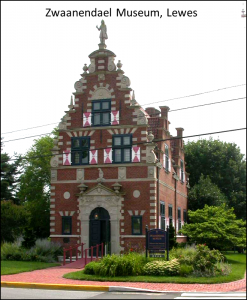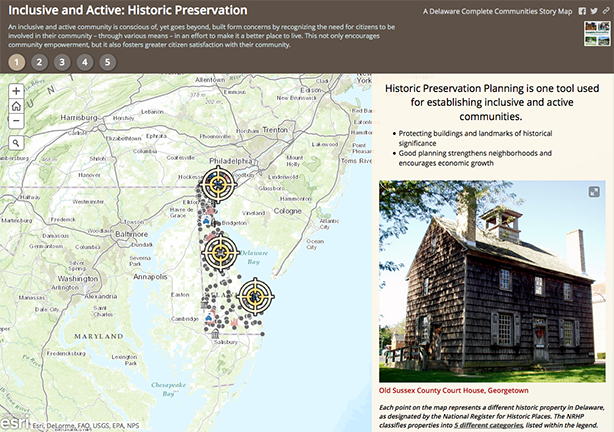What Is Historic Preservation?
Historic Preservation, as defined by the National Trust for Historic Preservation, is identifying, protecting, and enhancing buildings, places, and objects of historical and cultural significance. Government agencies, private entities, and individual citizens are all involved in these efforts.
Every community holds valuable pieces of the past. These historic elements are responsible for keeping a community’s collective heritage part of its present. The process of historic preservation helps to ensure that these ties remain strong and that those resources remain intact for the enjoyment of future generations.
The National Historic Preservation Act of 1966 established that the federal government would work to preserve the nation’s historic places by working with state and local governments. Today, the resources the NHPA created continue to bolster preservation efforts throughout the United States.
Topics in this section
- Guiding Principles
- Benefits of Historic Preservation
- How Historic Preservation is Compatible with Complete Communities
- Components of Historic Preservation Planning
- How Historic Preservation can be used in Delaware
- Examples of Historic Preservation
- Resources for Historic Preservation
Visual resources
GIS StoryMap on Historic Preservation
This GIS StoryMap showcases historic preservation as a tool to achieve an inclusive and active community that is conscious of built form concerns by recognizing the need for citizens to be involved in their community in an effort to make it a better place to live. As defined by the National Trust for Historic Preservation, historic preservation is the act of identifying, protecting, and enhancing buildings, places, and objects of historical and cultural significance.
Narrated Video on Historic Preservation
This video discusses how historic preservation can build Complete Communities. Historic preservation strengthens neighborhoods, placed-based economic development, encourages local economic growth, and conserves natural resources.
Guiding Principles
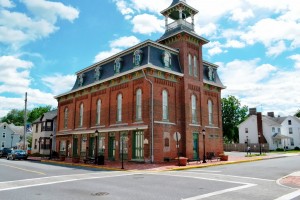 The purpose of preservation is to protect the distinctive historic qualities of old places. It is not simply making old buildings look new. New materials should only be introduced when original materials are not adequate or repairable.
The purpose of preservation is to protect the distinctive historic qualities of old places. It is not simply making old buildings look new. New materials should only be introduced when original materials are not adequate or repairable.
Historic places may be used for their original purposes, or be put to use in other ways that allow them to retain their significance. An example of this would be converting a former school house into a visitor’s center.
Historic preservation can serve a variety of purposes. A community may choose to preserve a building or district because of its historical importance, as part of beautification projects, or in an effort to increase tourism.
Preservation projects can be intimidating, but help is available. There are many resources available to communities and individuals interested in protecting pieces of the past.
Benefits of Historic Preservation
 Preservation strengthens neighborhoods
Preservation strengthens neighborhoods
Preserved residential and commercial spaces are an asset to their communities. A compilation of studies on historic preservation by the Advisory Council for Historic Preservation has concluded that home values within a historic district rise more quickly than comparable areas and that buyers are willing to pay a premium for homes in preservation zones. Historic residential and commercial areas are often found near one another in the heart of towns and cities and benefit from this proximity. Preserved structures add character and charm, enhance neighborhood pride, and fosters a strong cultural identity among generational residents
Preservation complements place-based economic development
Heritage tourism provides opportunities for place-based economic development, especially in rural areas. According to the National Trust for Historic Preservation, “place-based strategies build on the existing, unique assets [of] areas, including natural and scenic amenities, cultural heritage and traditions, and distinctive historic structures and landscapes. Protecting and enhancing these assets contributes to an improved quality of life that helps retain existing residents and attract new investment.”
Preservation encourages local economic growth
Historic preservation creates positive economic benefits and jobs for Delawareans. According to a study prepared by the Delaware Division of Historical and Cultural Affairs in 2010, for every $1 million spent on rehabilitation, 14.6 jobs are created. Rehabilitation offers a higher return on investment in terms of job creation than new construction or manufacturing. Preservation work depends more heavily on the work craftsman than the purchase of raw materials. Therefore, in comparison to new construction, preservation more directly benefits local businesses. Communities that take action to preserve pieces of their heritage also attract visitors, new residents, and investment.
Preservation conserves natural resources
Restoring older commercial and residential buildings is environmentally responsible. Historic preservation, as a form of infill development, provides usable and attractive buildings on land that is already developed. Heritage conservation helps to reduce reliance on new materials, environmentally unfriendly building materials, and energy intensive production of new building materials. In addition, many features of historic structure such as awnings, overhangs, and shutters are designed to take advantage of natural light to enhance energy efficiency.
How is Historic Preservation Compatible with Complete Communities?
Complete Communities are economically and environmentally sustainable. Preservation helps attain this ideal because it helps communities spur economic growth while also conserving natural resources. The State of Delaware has recognized the relationship between sustainability and preservation and highlighted its importance in many documents. Delaware’s Historic Preservation Plan provides guiding principles that can inform local governments in making land-use decisions or are updating and amending their comprehensive plans. Delaware Strategies for State Policies and Spending prioritizes state investments in areas that are most prepared for growth. Investment Level 1 areas, often dense and historic downtown cores, are ideally suited to direct state investment and management resources.
Promotes Infill Development
Complete Communities that practice infill development use both existing infrastructure and strive for redevelopment of vacant or underutilized land. Historic preservation makes this goal possible through ensuring that older buildings retain their character, cultural significance, and practical value to a community. For example, historic storefronts may continue to serve as important commercial space if preserved and maintained properly. State Strategies also promotes rehabilitation of aging housing stock as a way to improve housing options within existing communities.
Bolsters Economic Development
Complete Communities that value their collective heritage promote job growth and business diversity when they use historic preservation as a vehicle for economic development. Communities with character and charm attract both new residents and businesses. Rehabilitating older homes and properties encourages job growth, often more so than new construction. Heritage tourism, using historic structures and landscapes to attract and serve visitors, is another way that communities can encourage economic development and protect pieces of the past. State Strategies identifies heritage tourism as especially applicable to rural economic development. A community’s history is a resource that can be leveraged for economic benefit.
Conserves Natural, Cultural, and Historic Resources
Complete Communities that use historic preservation also conserve their natural environments. Adaptive reuse, or giving new use to older buildings, is responsible environmental management. Many jurisdictions have adopted adaptive reuse ordinances to incentivize or streamline the process of renovating existing buildings for new business uses. Restoring and preserving existing structures often provides more environmental benefits than new construction according to the National Trust for Historic Preservation and its Preservation’s Green Lab program. Rehabilitation of historic places in Investment Level 1 areas minimizes sprawl and expansion into auto-oriented, low-density areas. Preserving a community’s history can also conserve its precious natural resources.
Components of Historic Preservation Planning
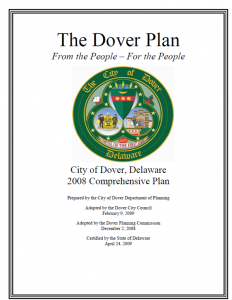 Including historic preservation in a community’s comprehensive plan provides a foundation for establishing planning, zoning, and capital investment policies that protect historic places. The benefits of this foresight are maximized through cooperation among local, state, and federal agencies such as the State Historic Preservation Office, DelDOT, the Office of State Planning Coordination (OSPC), and The National Trust for Historic Preservation.
Including historic preservation in a community’s comprehensive plan provides a foundation for establishing planning, zoning, and capital investment policies that protect historic places. The benefits of this foresight are maximized through cooperation among local, state, and federal agencies such as the State Historic Preservation Office, DelDOT, the Office of State Planning Coordination (OSPC), and The National Trust for Historic Preservation.
Municipal Planning Checklists, developed by OSPC, recommend that comprehensive plans include a chapter to address the need to preserve community character through historic preservation, the protection of the natural environment, and the enhancement of cultural institutions. A historic preservation chapter of a comprehensive plan should be prepared by a jurisdiction’s planning commission and municipal staff with input from citizens, ethnic groups, nonprofit organizations (e.g., Preservation Delaware), educational institutions, museums, and other historical, environmental, and archaeological societies. The comprehensive plans of Milford and Newark serve as examples for how to acknowledge the importance of preservation in official planning documents. Many comprehensive plans include a Historical Resources Map. The City of Dover’s historic preservation component of its comprehensive plan also provides a map that delineates National Register of Historic Places individual sites and historic districts as well as the City’s historic district zone.
Finally, local governments should also consider possible impacts of land use changes and development to the preservation of historic resources. The Preliminary Land Use Service (PLUS) process, coordinated by the Delaware Office of State Planning Coordination, provides state agency review of major land use change proposals prior to submission to local governments. It ensures that proposed changes in land use have no detrimental impacts, such as to historic properties, sites, or resources.
Local Government Strategies
To encourage historic preservation in their communities, local governments can:
- Gain recognition for Delaware’s historic sites through encouraging nominations to the National Register of Historic Places.
- Educate local officials and citizens on the benefits of historic preservation.
- Promote the adaptive reuse of historic buildings.
- Promote awareness of the state Historic Tax Credit Program that can assist property owners in preserving and rehabilitating their historic properties.
- Adopt historic design standards, or work with property owners to ensure that new construction is not out of character with the historic district.
- Join or learn more about resources provided by Downtown Delaware that seeks to provide Delaware’s historic downtowns, communities, and small businesses with tools to revitalize their commercial districts, increase entrepreneurship and innovation, and enhance quality of place.
- Continue education and advocacy to enhance the economic and community development potential of historic preservation programs, such as Historic Districts, Heritage Tourism, Main Street (Downtown Delaware), Scenic Byways, Agriculture Preservation, and Rural Conservation.
Local Government Policies
Adopting policies that support historic preservation is the best way local governments to ensure that historic treasures remain part of their communities for generations to come. Historic districts, geographically-specific areas that have a high concentration of significant properties, can be established by local governments to protect the historic integrity of specific neighborhoods. They are governed by zoning standards that encourage sensitivity to historic character. Many communities, including the City of Lewes have created Historic Preservation Commissions that serve in an advisory role to local governments, and may also be used to oversee standards set in place by historic districts. Demolition review laws are another important tool that can be used by local governments. These laws require that before applications for demolition are granted, that their possible historic significance is investigated. All of these policies, and others that receive similar results, may be adopted by local governments individually or incorporated into a historic preservation ordinance that provides regulations applicable to historic properties.
How Can Historic Preservation be used in Delaware?
 Preservation is more than repairing aging buildings. It is a technique for encouraging economic vitality and preserving cultural identity that is already working in The First State.
Preservation is more than repairing aging buildings. It is a technique for encouraging economic vitality and preserving cultural identity that is already working in The First State.
Tourism is a $2.1 billion industry in Delaware. Travelers are choosing Delaware as their destination of choice, and as a result, spurring economic growth. Practicing historic preservation is one way communities can attract tourism dollars. Communities can showcase their historical significance by joining the Delaware History Trail, creating walking tours that highlight historic locations, and adding preserved buildings to Delaware’s Geocaching Trail.
Historic preservation is keeping Delaware’s maritime, agricultural, and industrial heritage alive. From the arrival of the Dutch at Lewes in 1630, to Milford’s shipbuilding dominance from the late 1700’s through World War II, Delaware has had a prominent role in maritime history. Efforts such as the preservation of the Lightship Overfalls in Lewes and the Indian River Life Saving Station in Rehoboth Beach celebrate and commemorate Delaware’s sea faring legacy.
Agriculture is still the predominant land use in Delaware. The Delaware Agricultural Museum and Village educates visitors on Delaware’s historic contributions to the industry as well as farming’s continued role in the life of Delawareans. The John Dickinson Plantation, the preserved home of a revolutionary leader, gives light to the lives of those in rural 18th Century Delaware and its owner’s role in the founding of our nation.
The arrival and expansion of industry in Delaware has played an immense role in the state’s development. Constructed in 1802, the Hagley Museum brings visitors to a DuPont powder works and tells the story of early industrialism in northern Delaware. Winterthur, a 1839 home that gives testament to the wealth of the DuPont family, is furnished in period pieces and holds one of the foremost collections of Americana. The Seaford Museum, run by the Seaford Historical Society, traces DuPont’s wartime production of parachutes to its long run as the nylon capital of the world.
Preservation is a powerful tool that Delaware communities can use to foster economic development, tourism, and sustainability initiatives. Communities can develop strategic historic preservation plans, in collaboration with the State Historic Preservation Office, to capitalize on their unique historic resources that have a proven positive impact on economic development, heritage tourism, and quality of life.
Examples of Historic Preservation
City of Lewes, Delaware
Lewes is a prime example of a Delaware community that has adopted historic preservation initiatives. Beginning in 1960, citizens began efforts to preserve the town’s heritage through historic preservation. The establishment of the Lewes Historical Society allowed community members to purchase and preserve historic structures.
The City of Lewes has also been instrumental in preventing the destruction of the town’s historic attributes. In 2004, Lewes crafted a historic preservation ordinance that was adopted by its mayor and council members. The ordinance provides official guidelines that ensure the community’s historic ambiance is persevered and reflect its blend of Colonial, Federal, Victorian, Delaware Vernacular and Contemporary Architectural Styles. With the passage of the ordinance, the City also established a historic preservation commission. The commission is responsible for determining if aesthetic changes made to structures within the historic district are in keeping with the town’s core values. The work of Lewes’s local government has bolstered that of private citizens determined to protect the town’s heritage.
The Queen Theater, Wilmington
Often, the goals of economic development and historic preservation intersect. Originally constructed in 1872, the Queen Theater located in the heart of Wilmington, sat empty for more than 50 years. In 2011, the Buccini/Pollin Group and the Light Up the Queen Foundation partnered to purchase the building and restore it to its original grandeur. The site’s developer also points to help from the city of Wilmington and federally provided New Market Tax Credits as having been instrumental in the Queen’s success. Today the Queen serves as a venue for live music, including “World Café Live.” It also serves as an anchor for further revitalization work in downtown Wilmington.
Schwartz Center for the Arts, Dover
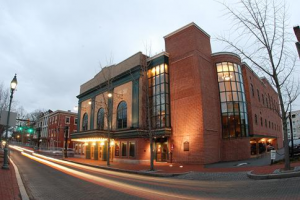 Dover’s Schwartz Center for the Arts has enjoyed a prosperous past. Built as the Dover Opera House in 1904, it later became a successful movie theater. However, from 1982 until 2001 the theater was unused and fell into disrepair. In 2004 a coalition between Wesley College, Delaware State University, and The Friends of the Capitol Theater purchased the theater and began the restoration process. They re-opened the space to be used as the premiere performing arts center in central Delaware. The Schwartz for the Arts is an important cultural resource for Dover, its academic institutions, and surrounding communities that was made possible through historic preservation.
Dover’s Schwartz Center for the Arts has enjoyed a prosperous past. Built as the Dover Opera House in 1904, it later became a successful movie theater. However, from 1982 until 2001 the theater was unused and fell into disrepair. In 2004 a coalition between Wesley College, Delaware State University, and The Friends of the Capitol Theater purchased the theater and began the restoration process. They re-opened the space to be used as the premiere performing arts center in central Delaware. The Schwartz for the Arts is an important cultural resource for Dover, its academic institutions, and surrounding communities that was made possible through historic preservation.
Resources to Begin Using Historic Preservation in Your Community
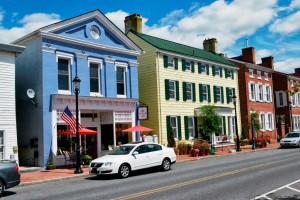 Individuals and communities don’t have to “go it alone” when they begin preservation work. The State of Delaware and the Federal government offer many resources that enable and encourage the practice of historic preservation. In addition, each county and the City of Wilmington have preservation planners on their staffs that can provide expertise and advocate for the protection and appropriate treatment of historic properties. Utilizing these resources can improve the quality of preservation efforts and may also provide financial incentives.
Individuals and communities don’t have to “go it alone” when they begin preservation work. The State of Delaware and the Federal government offer many resources that enable and encourage the practice of historic preservation. In addition, each county and the City of Wilmington have preservation planners on their staffs that can provide expertise and advocate for the protection and appropriate treatment of historic properties. Utilizing these resources can improve the quality of preservation efforts and may also provide financial incentives.
State Historic Preservation Office and Certified Local Governments
The State of Delaware offers many resources to individuals and communities practicing historic preservation. The Delaware State Historic Preservation Office (SHPO) works as a liaison between the federal government and Delaware residents to protect historic places that could be adversely affected by projects carried out by federal agencies. The State Preservation Office is also responsible for determining which properties in Delaware qualify for the National Register of Historic Places through its state review board. Local governments that recognize the importance of historic preservation and its role in creating sustainable, economically-viable communities are encouraged to pursue Certified Local Government (CLG) status. The CLG Program strengthens preservation efforts at the local-level by providing technical and financial assistance, while encouraging successful preservation programs and practices. CLGs may apply for grants to pursue various historic preservation-related projects and programs. Delaware’s Historic Preservation Tax Credit Program assists in preserving and rehabilitating historic buildings throughout Delaware. These state tax credits help offset the cost of preservation for homes and historic places listed on the National Register of Historic Places.
State Historic Preservation Plan and Resources
The Delaware SHPO has published Preserving our Past for a Better Future: Delaware’s Historic Preservation Plan, 2013-2017. The five goals and related strategies within the plan should be considered by local jurisdictions when updating and amending their comprehensive plans. The plan also outlines several programs and incentives to identify and preserve historic properties. Preserve America, a federal program administered by the Advisory Council for Historic Preservation (ACHP), has recognized three Delaware communities for their efforts to preserve their cultural and natural assets. The Preserve America matching-grant program provides planning funding to designated Preserve America Communities to support preservation efforts through heritage tourism, education, and historic preservation planning. The National Main Street program also incorporates preservation values in program initiatives. DelDOT’s Byway Program is another tool that communities use to develop heritage tourism.
Federal Government Resources
The Federal government also provides resources that help communities begin using historic preservation. The General Services Administration is home to the Center for Historic Buildings, which focuses on design solutions and building investment techniques that are in keeping with The National Historic Preservation Act. Their work in turn benefits all of those seeking to renovate a historic structure without damaging its character. The National Park Service’s Technical Preservation Services also offers advisory services to preservationists. The National Park Service administers federal tax credits for preservation work as well.


